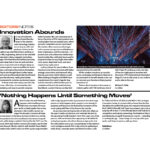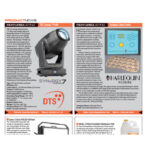
Jason Reberski is the CEO of JRLX, Inc., a Chicago-based lighting production company that provides touring production, lighting, and visual solutions as well as technical sales and systems integration. Reberski also maintains the Vintage Fog Machines Group on Facebook where you can find photos, videos, and just about anything you ever wanted to know about fog machines. He is very serious about his passion for fog and smoke effects and what they can bring to a production, whether it’s a touring production, a play or musical, dance piece, or wherever fog and smoke can create the right atmosphere for designers. Reberski, whose experience includes working as a freelance lighting designer, was speaking with another lighting designer/lighting production company owner, Matthew Shimamoto about the “good old days of simple fog and smoke machines” and what they brought to live events to define beams of light. That conversation got Reberski interested in sharing his knowledge of “what’s old is new again” with PLSN. In the following essay he looks at bringing back fog and fans to get that just right atmosphere you might not have known how to reliably produce.
Once upon a time, there were no hazers… Of course, I’m not talking about “oil cracker” barrels which existed, along with their evil proclivities to put an oily film on everything from camera lenses to lighting consoles. When glycol fog was first developed by the late Günther Schaidt in Germany in the mid-1970s, it was a major improvement to the technology at the time. So naturally, when I started in the industry, to enhance lighting, we would put a Rosco 1500 Fog/Smoke machine upstage left running Rosco Green Fluid with a Vornado fan and dial the output down to a trickle. It was some of the best-looking haze I had ever used. More than once I have also placed a High End Systems F-100 Fog Generator and a fan in a catwalk to haze an entire theater and it always worked like a charm. In the 1990s, my friend Richard Cadena even wrote an article called Building an Active Fog Distribution System in which he discussed a forced-air blower system to distribute fog through ducting and into a fine haze for entire venues. This little trip down memory lane started me thinking about how we got to where we are today.

Dedicated Hazers
With the advent of the Reel-EFX DF-50 Diffusion Hazer, a trend away from fog machines and fans and toward dedicated haze machines began—so much so in fact that it almost seemed as if knowledge of “the old way” was lost in our industry. All the while, the film and TV professionals haven’t changed their approach to creating haze on set, and perhaps for good reason! They rarely utilize dedicated haze machines, and instead opt for fog machines to create almost all their atmospheric effects with a limited amount of equipment on their special effect trucks.
Recently, my friend and colleague Matt Shimamoto, owner of Volt Lites and I were lamenting the fact that there is a global hazer shortage and I half-jokingly mentioned that we should start sending out only foggers and fans on our tours again—after all, they are incredibly reliable. The conversation turned somewhat serious as we both pondered the practicality of this concept. Matt and I both agreed that with the correct fluid, a machine that has good low-end control, and a proper DMX controlled fan, this was a viable, reliable option.
Shimamoto notes, “While hazers are a workhorse solution for even distribution, the simple solution of a fogger with a controllable fan has piqued our interest as more shows have headed outdoors. The reliability and controllability of a modern fogger has allowed us to distribute haze even more effectively in large scale projects and outdoor environments.”
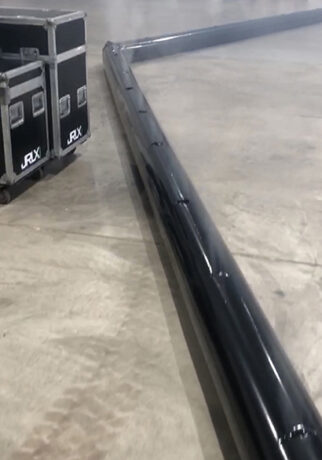
Making Haze (with Fog)
The key to achieving a successful haze effect with a fog machine comes down to a few main factors. First, you will need a fog machine that has good low-end control; meaning that ideally, it must be able to consistently output a small trickle of fog (less critical if your application is outdoors or very large scale). Second, a long-lasting, slow evaporating fog fluid made of higher molecular weight, low vapor-pressure glycols is required. Triethylene glycol is the most commonly used “long lasting” fluid component and occasionally glycerin or polyethylene glycol 200 or 400 is also used. Third, a good fan is a must. Almost any fan will work if it is quiet and moves enough air to properly aerate the long-lasting fog into a haze. The range of DMX fans available on the market is now vast and will allow you to achieve finer control over your haze. This is particularly important for theatrical applications where not only noise, but controllability is crucial.

The Benefits of Fog-Induced Haze
What are the benefits of using a fog machine to generate haze effect? It’s important to not become fixated on the idea of “fog” versus “haze”. For the purposes of this article, what we are really talking about is the use of a combination of equipment to achieve a specific effect. After all, that is really what we are after. For starters, think about how internally complex hazers are and how often they tend to break when compared to fog machines. One can easily change the combination of fluid, fan type and speed, fog machine volume, and placement to achieve a variety of haze effects—some of which cannot be attained with a hazer alone. Perhaps you want to have one scene with a hazy stage and the next, you want clear air. When you must fill a large area with haze quickly, you can simply run the fog machine and fan at higher volumes and then dial them back to maintain an even haze. In the case of outdoor venues, fog and fans almost always work better at combating errant wind currents too. We can also take a page from our film and TV colleagues’ book with their “tube of death” technique by pairing a fog machine with a carpet-drying blower and pressurizing long runs of perforated polyethylene tubing. This tubing will emit long curtains of finely diffused haze by aerating the fog and dispersing it over large areas. But even without complex ducting and blowers, the right fog machine with long-lasting fluid and a high velocity fan, placed in an inconspicuous area (or a conspicuous area if you enjoy the aesthetic) can achieve a very convincing haze effect.
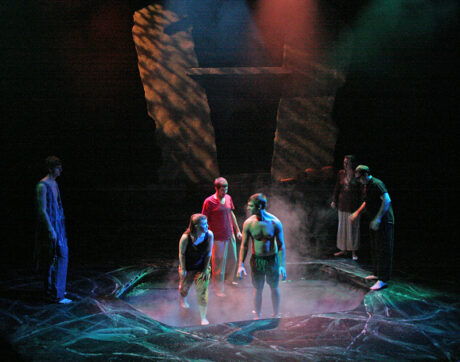
A secondary benefit is that by selecting a medium-hang-time fluid and some careful cueing, you can achieve haze effects that don’t last long, and where the stage becoming clear again is almost like a new effect on its own. This is particularly useful in theater where, for instance, you might want to quickly introduce haze on stage after a quick scene change, but don’t want it to linger into the next scene.
Finally, consider the fact that from an equipment standpoint, everything becomes more unified. Production companies can acquire more of the same type of machine which can be used to achieve multiple effects from smoke, to fog, to low fog; not solely haze effects. Theater companies don’t need to own multiple machines either to achieve whatever effect the script throws at them. Replacement part stocks become more unified as well. At JRLX, we have a wide range of atmospheric equipment in our touring rental stock including hazers and fog machines; however recently, we have begun investing in more fog machines and DMX fans for exactly these reasons.
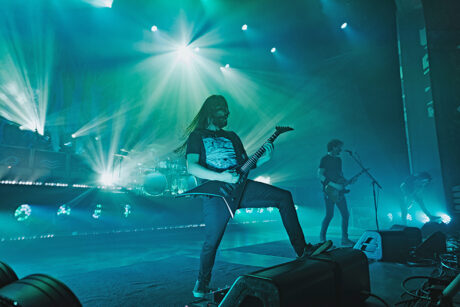
Choosing the Right Effect
Now that’s not to say that there aren’t times when this approach won’t achieve the correct effect. For instance, an extremely fine theatrical haze, the kind that is almost imperceptible and only exists for subtle lighting beam enhancement may be better attained with a dedicated hazer in some applications. However, for the vast majority of live performances, the proper combination of a high-quality fog machine, a long-lasting fluid, and a high-velocity DMX fan can create a perfect, and in some cases, more effective lighting enhancement haze effect. It is after all the way that it was done for many years, and it is making a comeback. Perhaps what is old is finally becoming new again.
You can learn more about vintage fog machines at Reberski’s Vintage Fog Group on Facebook: https://www.facebook.com/groups/2797550580494424

